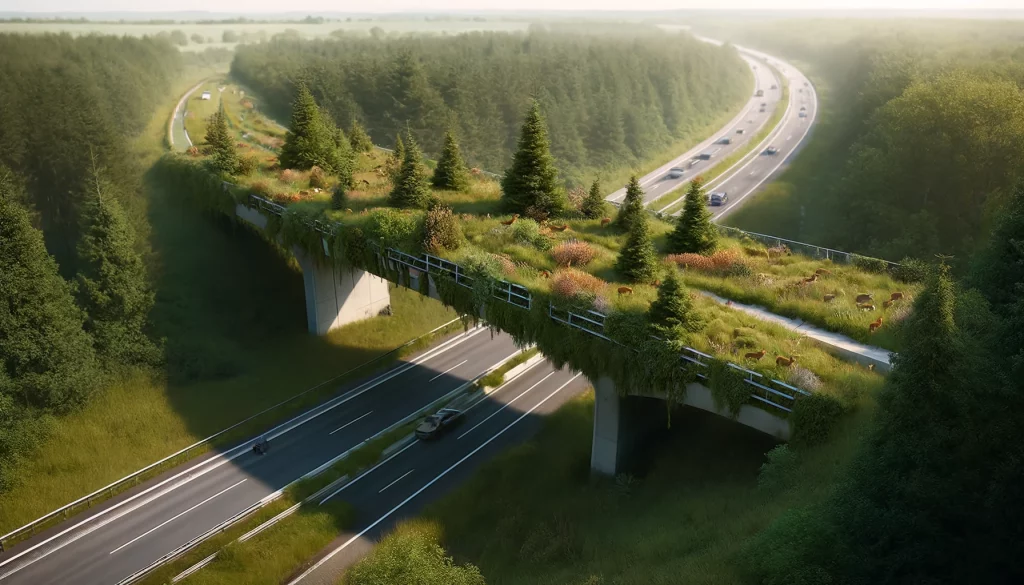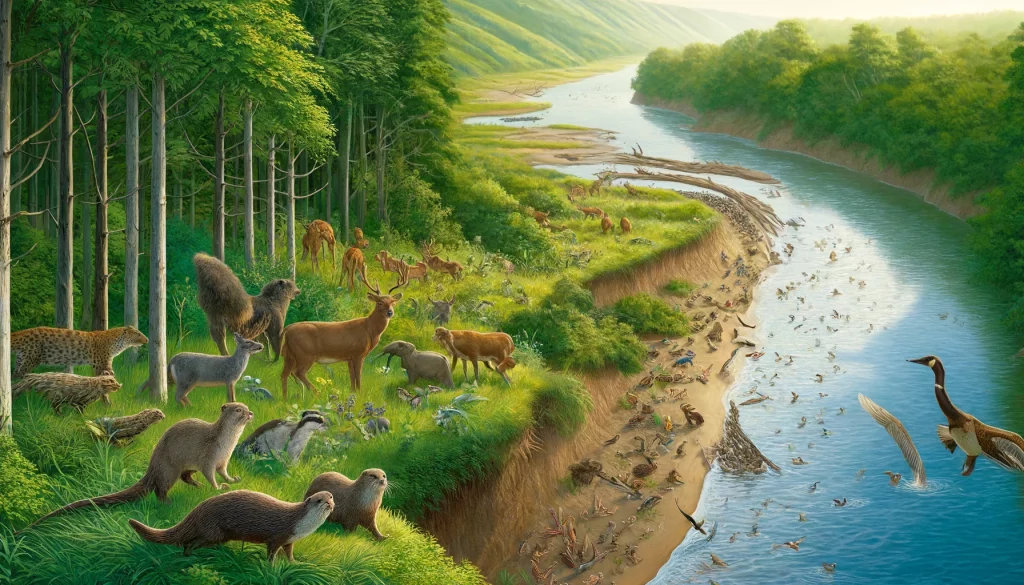Introduction
Imagine a world where animals are trapped in isolated patches of habitat, unable to migrate, find mates, or access vital resources. This is the harsh reality for many species today due to habitat fragmentation caused by urban development, agriculture, and infrastructure projects. Habitat fragmentation not only isolates wildlife populations but also threatens biodiversity and ecological balance. However, there is a beacon of hope in the form of wildlife corridors, which act as lifelines connecting these fragmented habitats.
Wildlife corridors are essential for the movement of animals and the flow of ecological processes across landscapes. They play a crucial role in maintaining biodiversity, promoting genetic diversity, and ensuring the survival of numerous species. This article explores the significance of wildlife corridors, their benefits, challenges, and real-world examples of successful implementations.
Understanding Habitat Fragmentation
Definition and Causes
Habitat fragmentation occurs when large, continuous areas of natural habitats are divided into smaller, isolated patches. This fragmentation is primarily caused by human activities such as urban development, agriculture, and the construction of roads and other infrastructure projects (Yale E360) (National Wildlife Federation). As natural landscapes are increasingly converted for human use, the once expansive and connected habitats are broken into smaller segments, drastically reducing the ability of species to move freely across the landscape.
The expansion of urban areas leads to the construction of roads, buildings, and other infrastructure that can create physical barriers for wildlife. Similarly, agricultural development often involves clearing large tracts of land, which not only removes habitat but also creates fragmented landscapes. These human activities can drastically alter the natural environment, leading to isolated populations of wildlife that struggle to survive in the smaller, disconnected patches of habitat left behind.
Consequences of Fragmentation
One of the most significant consequences of habitat fragmentation is the loss of biodiversity. Smaller habitat patches can support fewer species, leading to a decline in species richness. Isolated populations are more vulnerable to extinction due to environmental changes, disease, and other factors. Reduced habitat size also limits the availability of resources such as food and shelter, further stressing wildlife populations (Golden Gate National Parks Conservancy) (Mongabay-India).
Another consequence of fragmentation is increased human-wildlife conflict. As animals are forced to navigate human-dominated landscapes to find food and mates, encounters with humans become more frequent. This can lead to conflicts such as crop damage, livestock predation, and vehicle collisions. These conflicts can have serious consequences for both wildlife and human communities (National Wildlife Federation).
Fragmentation also leads to genetic isolation. When populations are isolated, inbreeding becomes more common, which can result in genetic defects and reduced fitness. This genetic isolation makes it harder for populations to adapt to changing environmental conditions, increasing their vulnerability to extinction. Inbreeding depression, where closely related individuals breed, can lead to a decrease in reproductive success and an increase in genetic disorders, further jeopardizing the survival of the population (Yale E360) (Mongabay-India).
What Are Wildlife Corridors?
Definition and Types
Wildlife corridors are designated routes that allow animals to move safely between isolated habitat patches. These corridors can be natural, such as rivers and mountain ranges, or man-made, such as wildlife overpasses and underpasses (National Wildlife Federation) (Golden Gate National Parks Conservancy). The primary goal of these corridors is to facilitate animal movement and ensure the flow of ecological processes like seed dispersal and pollination.

Natural corridors, such as riverbanks, ridgelines, and forested strips along mountain ranges, inherently support animal movement by providing continuous, unbroken habitat pathways (Yale E360). These natural features can serve as lifelines for wildlife, allowing them to move freely across the landscape and access the resources they need for survival.
Man-made corridors, such as wildlife overpasses and underpasses, are specifically constructed to help animals cross human-made barriers like highways and railroads. These structures are designed to blend with the natural environment and provide safe passage for various species. For example, wildlife overpasses are often covered with vegetation and mimic the surrounding habitat, making them attractive to animals. Similarly, underpasses are constructed to resemble natural tunnels and are strategically placed to connect important habitat areas (National Wildlife Federation) (Mongabay-India).
Key Features
Effective wildlife corridors ensure connectivity between habitat patches, allowing animals to travel for breeding, foraging, and seasonal migration (Golden Gate National Parks Conservancy). Connectivity is crucial for maintaining healthy wildlife populations and ensuring the flow of genetic material between isolated groups. By facilitating movement, corridors help prevent the negative effects of inbreeding and genetic isolation.
Corridors are designed to minimize risks associated with human activities. Features like fencing along highways and dedicated crossing points reduce the chances of wildlife-vehicle collisions (National Wildlife Federation). These measures not only protect wildlife but also enhance human safety by reducing the risk of accidents. For example, fencing can guide animals towards safe crossing points, such as overpasses and underpasses, thereby reducing the likelihood of animals attempting to cross busy roads.
By providing safe routes, wildlife corridors help maintain natural animal behaviors such as migration and dispersal, which are critical for species survival and ecological balance. Migration allows animals to access different habitats and resources throughout the year, while dispersal helps young animals find new territories and reduce competition for resources. Corridors also support other ecological processes, such as seed dispersal and pollination, which are essential for maintaining healthy ecosystems (Mongabay-India).
Benefits of Wildlife Corridors
Ecological Benefits
Wildlife corridors promote species richness by connecting isolated habitats, allowing plants and animals to spread and thrive. Studies have shown that areas linked by corridors can support 20% more plant species compared to isolated areas (Yale E360). For example, research conducted in the Savannah River Site in South Carolina demonstrated that corridors facilitated the movement of plant seeds and animal species, resulting in increased biodiversity (Mongabay-India).

Corridors facilitate the movement of keystone species, which play critical roles in maintaining the structure of an ecosystem. For instance, predators like the Florida panther and large herbivores such as elk help regulate prey populations and vegetation growth. By providing safe passage for these species, corridors contribute to the overall health and stability of ecosystems (National Wildlife Federation) (Golden Gate National Parks Conservancy).
By enabling animals to move between fragmented habitats, wildlife corridors reduce genetic isolation and inbreeding. This genetic flow is crucial for the long-term survival and adaptability of species. The introduction of new genes from different populations can enhance disease resistance and reproductive success among wildlife populations. For example, the introduction of Texas cougars into the Florida panther population helped increase genetic diversity and improve the health of the species (Yale E360) (Mongabay-India).
Challenges in Implementing Wildlife Corridors
Funding and Resources
Implementing wildlife corridors requires significant financial investment and resources. Securing funding for such projects can be challenging, especially in regions where there is limited budget allocation for conservation efforts. Additionally, maintaining these corridors over time to ensure they remain effective and safe for wildlife also requires ongoing financial support and resources (National Wildlife Federation) (Golden Gate National Parks Conservancy).
Land Ownership and Legal Issues
Wildlife corridors often need to traverse multiple parcels of land, which may be owned by various private and public entities. Negotiating land use and acquiring the necessary permissions can be a complex and time-consuming process. Legal issues related to land ownership, zoning, and property rights can pose significant hurdles to the development and implementation of wildlife corridors (Yale E360) (Mongabay-India).
Human-Wildlife Conflicts
As wildlife corridors facilitate the movement of animals across landscapes that are often close to human settlements, they can sometimes lead to increased human-wildlife interactions. These interactions can result in conflicts such as crop damage, livestock predation, and risks to human safety. Effective management strategies are required to minimize these conflicts and ensure that both wildlife and human communities can coexist peacefully (National Wildlife Federation).
Habitat Quality and Maintenance
The effectiveness of a wildlife corridor is heavily dependent on the quality of the habitat it provides. Degraded habitats, invasive species, and other environmental stressors can reduce the effectiveness of corridors. Continuous monitoring and maintenance are essential to ensure that these pathways remain conducive to wildlife movement and ecological processes (Golden Gate National Parks Conservancy) (Mongabay-India).
Real-World Examples of Successful Wildlife Corridors
The Banff Wildlife Corridors, Canada
In Banff National Park, a series of wildlife corridors have been established to help animals navigate the human-altered landscape. These corridors include overpasses and underpasses designed to allow safe passage for species such as grizzly bears, elk, and wolves. The success of these corridors has been well-documented, with thousands of animal crossings recorded annually, significantly reducing wildlife-vehicle collisions (Yale E360) (National Wildlife Federation).
The Mesoamerican Biological Corridor, Central America
The Mesoamerican Biological Corridor is one of the most ambitious wildlife corridor projects in the world. It spans eight countries from southern Mexico to Panama, aiming to connect protected areas and ensure the movement of species across a diverse range of ecosystems. This corridor supports the migration of species such as jaguars and tapirs and promotes biodiversity conservation across the region (Golden Gate National Parks Conservancy) (Mongabay-India).
The Yellowstone to Yukon Conservation Initiative, North America
The Yellowstone to Yukon Conservation Initiative (Y2Y) is a collaborative effort to create a connected system of protected areas from Yellowstone National Park in the United States to the Yukon Territory in Canada. This initiative aims to facilitate the movement of wide-ranging species such as grizzly bears and wolves, ensuring they have access to large, interconnected habitats necessary for their survival. The Y2Y corridor has been instrumental in preserving biodiversity and maintaining ecological processes across this vast landscape (National Wildlife Federation) (Mongabay-India).
Conclusion
Wildlife corridors are vital tools in mitigating the adverse effects of habitat fragmentation. By providing safe passages for animals, these corridors help maintain biodiversity, promote genetic diversity, and ensure the long-term survival of numerous species. The successful implementation of wildlife corridors requires careful planning, adequate funding, and effective management strategies to address the various challenges involved.
Call to Action
To support the creation and maintenance of wildlife corridors, individuals and communities can advocate for conservation funding, participate in local conservation efforts, and support policies that prioritize habitat connectivity. By working together, we can help bridge the gap between fragmented ecosystems and secure a future where both wildlife and human communities can thrive.
Great! Here are four FAQs related to wildlife corridors, along with concise and informative answers:
FAQs
1. What are the main types of wildlife corridors?
There are two main types of wildlife corridors: natural and man-made. Natural corridors include features such as rivers, mountain ranges, and forested strips, which provide continuous habitat pathways for wildlife. Man-made corridors, like wildlife overpasses and underpasses, are constructed to help animals cross human-made barriers such as highways and railroads, ensuring safe passage and connectivity between habitats.
2. How do wildlife corridors benefit biodiversity?
Wildlife corridors benefit biodiversity by connecting isolated habitats, allowing species to migrate, find mates, and access resources. This connectivity promotes genetic diversity, reduces the risk of inbreeding, and helps maintain healthy wildlife populations. Corridors also support ecological processes such as seed dispersal and pollination, contributing to the overall stability and richness of ecosystems.
3. What challenges do wildlife corridors face?
Wildlife corridors face several challenges, including securing funding and resources, navigating land ownership and legal issues, and managing human-wildlife conflicts. Maintaining habitat quality and addressing environmental stressors such as invasive species are also critical for the effectiveness of these corridors. Continuous monitoring and maintenance are essential to ensure that corridors remain conducive to wildlife movement.
4. Can wildlife corridors help mitigate climate change effects on wildlife?
Yes, wildlife corridors can help mitigate the effects of climate change on wildlife by providing pathways for species to move to more suitable habitats as environmental conditions change. These corridors facilitate migration and dispersal, allowing species to adapt to shifting climates and find new areas with the necessary resources for survival. By enhancing connectivity, wildlife corridors help ensure the resilience of ecosystems in the face of climate change.
